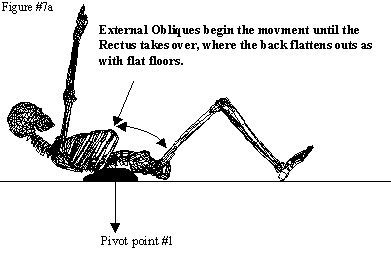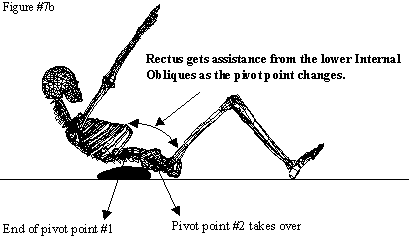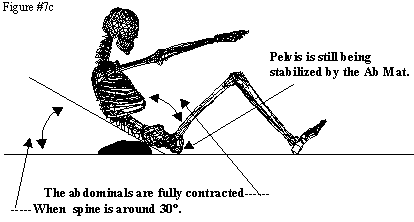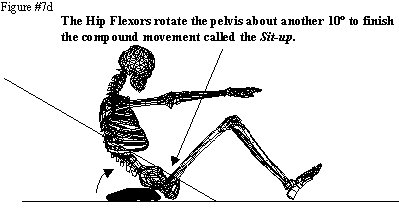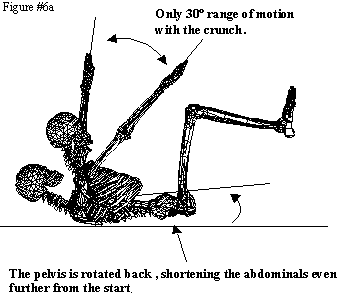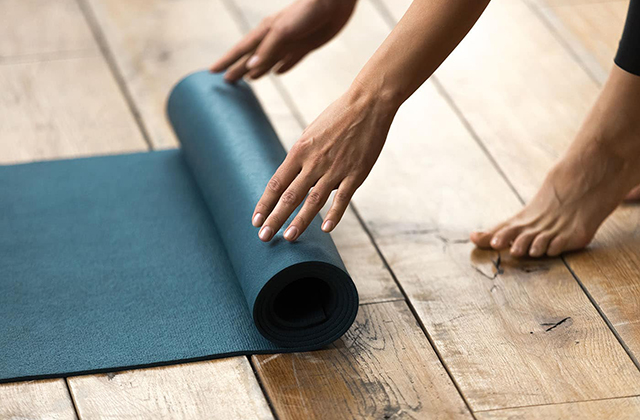Sit-ups Redefined by By Fred Koch, Robert K. Blom, R.P.T., Vidar Jacob, R.P.T. (Norway). In Polestarpilates.edu.au we want our Pilates teacher training Sydney to learn more on human anatomy so that they know how to apply an exercise for the injured body parts of their clients.
Did you ever notice how all-abdominal training articles are the same. The only new element is the models and how good their abs look. You could probably pick the top 3 exercises and find them described in every article, in one variation or another. But, is this all there is? We are now going to share some startling information with you. Many abdominal exercises are just not working the abdominals the way you think they do, for two simple reasons. An effective abdominal exercise:
- Must bend the spine in it’s full range of motion,
- While contracting the abdominal muscles from full extension to full flexion.
Ask yourself this question. Why are you doing crunches for your abs? We will repeat the question. Why are you doing crunches for your abs? Do any of you really know why? We do squats for legs, bench presses for chest, and rowing movements for back. These are all compound exercises. But why are we doing crunches for our abs, when we know it is not a compound exercise. If a compound exercise done properly is so good for every other body part, then what is the problem with sit-ups? The reason is, 20 years ago some experts said that they were bad for your back. Did anyone ever stop and ask if that was true, or why?
Keep in mind that for year’s people had criticized squats by saying they were dangerous for the back and knees. But there were no way athletes, bodybuilders and power lifters were going to stop doing squats, because they knew the benefits far outweighed the risks. So what did they do? They went in, analyzed the movement and tried to get it right bio-mechanically. And they did. Unfortunately, seemingly simple “sit-ups” were not evaluated with the same open but critical eye. It was a lot easier to just let the critics tell us sit-ups were bad for the back and that we should do crunches.
When first asking questions about the crunch or sit-up, we should start with a clear and correct definition of what the abdominal muscles do. The abdominal muscles (talking about the abdominals that flex the spine) are attached to the rib cage and the pelvis. No news there. When they contract, working together, they bend the spine from full extension of the spine to full flexion of the spine. What was left out of this statement is exactly what “full extension” and “full flexion” means. Full extension of the abdominals is not achieved when the back is flat on the floor, but rather when the spine is arched back or extended 15-30°, a position that the flat floor does not allow. Full flexion of the abdominals occurs when the lower back comes off the floor. This is not possible with a crunch. (See Figures 1,1a, 2,2a)
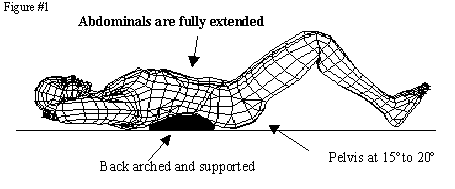

Full contraction of the abdominals means the abdominal muscles
shorten from maximal length to minimum length, bending the spine. What
was not understood until now is that this includes the pivot points of
the exercise moving down the spine and ending in the pelvis. For full
flexion to occur, the back must come off the floor as seen in the sit-up
redefined. The redefined sit-up, like the bench press, or squat, is
therefore a compound exercise using more than one joint.
If you look at figures 2, 2a, you can see this. Full contraction of the
abdominals can only happen 1) when contraction begins with the spine
fully extended and 2) when the pivot point slides downward toward the
pelvis on the spine during the movement. Neither of these requirements
is fulfilled during a crunch. So, you now have the two missing pieces of
the abdominal mystery, full extension of the spine and a sliding
fulcrum, or pivot point. For any workout to completely work the
abdominals these two ingredients must be present.


The Crunch
Let’s first take a look at the crunch. In the beginning of the exercise you must bend and raise your legs to set your back on the flat floor. This movement shortens the abdominals from their naturally stretched position before the movement even begins. If you look at figure 3a, you will also see that the pelvis is also tilted, further shortening the abdominals. This starting position will never allow the abdominals to contract in a full range of motion.

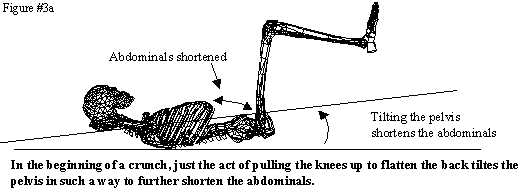
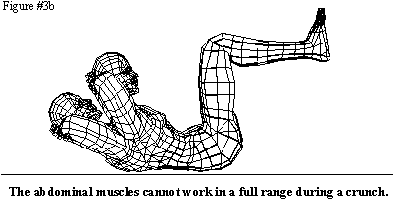
The Old Sit-Up
Now we can go back to the old sit-up. The movement of the trunk area
is so complex that it encourages numerous forms of “cheating.” So it is
important that we examine the sit-up movement with a more critical eye.
(Figure 4)
When this old exercise was performed it was usually done with the
thought in your mind ” how many reps can I do?” This quickly became “how
many times can I get my head to my knees”. Not, ” I want to use a
sit-up to maximally overload my abdominals in a full range of motion”.
The easiest way to do this is a dynamic head to knee movement with the
feet anchored. Being efficient, the body instantly determines what
muscles are going to be used in the movement, which ones are strong,
which ones are weak. Thus how does the body make us do that sit-up? The
first thing it does is create momentum by starting the head moving with a
snap. This starts the upward and forward movement (figures 4a, 4b).

Now the momentum is immediately picked up by the hip flexors. They begin contraction with the spine already partially flexed. The abdominals are forced into an isometric contraction, never really dynamically contracting under a load. By the time the sit-up reaches the stage the abdominals and

internal obliques should be most active at the end of the movement, so much momentum has been built up from this swinging that the workload is continued by the hip flexors. Momentum built up at the start of the movement eliminates the loading of the abdominals by forcing them to do an isometric contraction. Keep in mind the starting position was from a flat floor, so the movement began wrong. The abdominals were not working through a full range of motion and not allowing the spine to flex properly. (See figures 4a, 4b, 4c)
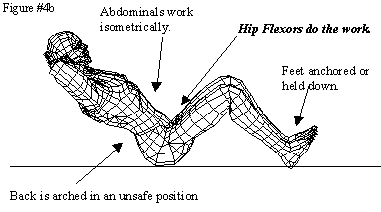
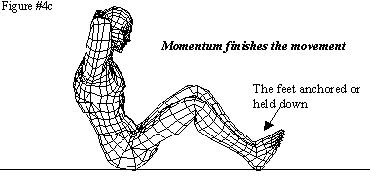
The following reps are even easier because the momentum from the downward movement increases the snap and momentum increases for the next rep (the so-called stretch reflex is brought into play). The body will, of course let the stronger muscles do the work. The hip flexors will continue to function as prime movers as long as the weaker abdominals can hold the isometric contraction. This whole fiasco usually ends when the abdominal muscles can no longer hold the isometric contraction. You feel a burn due to the isometric contraction of the abdominals trying to hold the spine stable while the hip flexors perform the movement. This improper form could have been the main reason so many people had back pain, due to the pulling on the spine by the hip flexor muscles.
Sit-up redefined
Let us now examine the Sit-up redefined. To do the correct movement lay flat on your back with an AbMat™ or rolled up towel under your lower back. (An improper device will not give the proper support) Bend the knees about 45° with heals on the floor. The feet should not be held down or anchored and the knees are spread apart to further reduce the use of the hip flexors. (See figure 5)
Put your hands between your legs. This will help you find the proper form from the beginning. Now, remember that the sole goal of the movement is to overload the abdominal muscles. Do not throw your head toward your knees. Concentrate on the origin of the abs at bottom of the rib cage.

- Start the curling of the spine movement by contracting the abdominals (external obliques and rectus abdominus) pulling you over the AbMat™.
- The rectus now takes over the entire load as you reach the old crunch position and continue the curling movement. You will notice the focus of the exercise now changes to the pelvic area.
- The lower internal obliques begin to help the abdominals to complete the final few degrees of spinal flexion. During this last part of the movement you will feel the AbMat™ supporting your lower back. We have found this support from the AbMat™ is “essential” in doing the movement correctly.
- You reach the end of this exercise when the hip flexors take over the work from the abdominals. When you lay down just reverse the movement. You are now working through almost twice the range of motion of the old crunch and with more overload to your abdominals. (See figures 5, 5a, 5b, 5c.)
Breathing during the exercise: Be sure to inhale at the beginning of the exercise and exhale as you are performing the sit-up.
When you use the AbMat™ for this exercise you notice how the back is extended in the beginning. This is a position you cannot take on a flat floor. In this position the abdominal muscles are fully stretched and ready for full contraction. You will now be able to work the abdominal muscles through a full range of motion almost doubling what could be achieved in a crunch. You will immediately feel the extra load place on the abdominals when worked by the redefined sit-up.
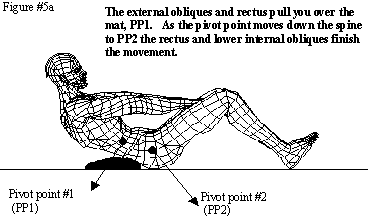
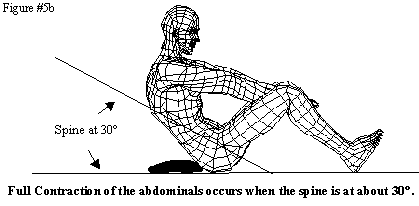
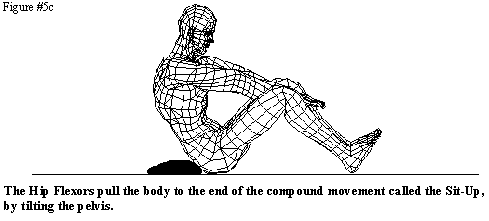
Figures 7, 7a, 7b, 7c, 7d, will help you understand the movement of the spine and pelvis through the sit-up.

